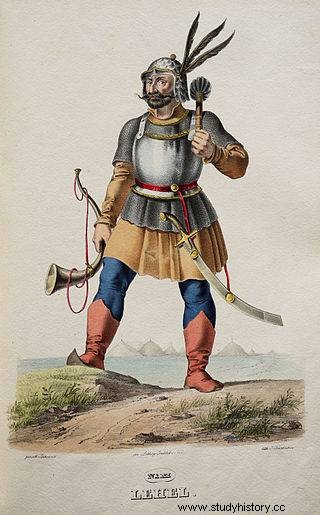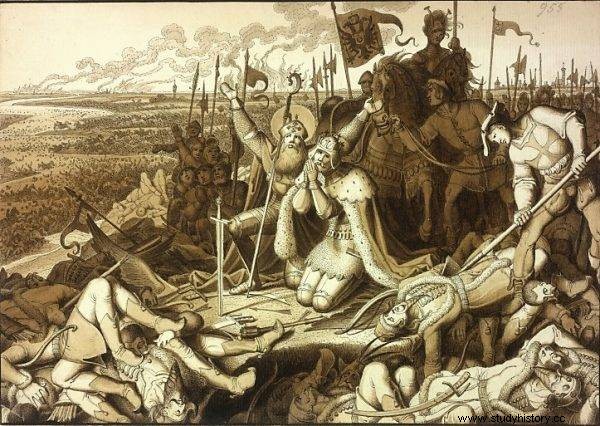They sowed death and destruction. They came from the Asian steppes. They occupied the Pannonian Basin, smashing Great Moravia and throwing the Franks away for the Alps. I am talking about ... Hungary.
The news of their invasions caused panic. These brilliant archers, moving fast on quick horses, have been plundering all of Europe on a regular basis for half a century . Their invasions, reaching even distant Spain, were marked by extreme cruelty. It was only stopped by the defeat in Lechowy Pole inflicted by the German Empire.
Nomads from beyond the Urals
The Ural is the cradle of today's Hungarians. They come from the local peoples - from their Finno-Ugric branch, which explains the language different in the Slavic ethnos. Originally the ancestors of Hungarians lived east of the Urals in the valley of the Irtysh and Ob rivers . Several thousand years B.C.E. abandoned their relatives, from which come, among others Finns, and moved south. Around the 5th century, the Hungarians began another journey. They moved west from the land located in the steppes of Kubiania (in the North Caucasus) or between the middle Volga and the Urals, later named by medieval chroniclers Magna Hungaria , that is Great Hungary .

The Magyars proved to be extremely dangerous invaders. They participated as an ally in the conquests in the West.
From the 5th century on, the Hungarian tribes began wandering further southwest. First on the Black Sea, then - as a result of clashes with the Pechenegs - they settled in Pannonia, leading to the collapse of the Slavic Great Moravian state and displacing the East Frankish state for the Alps. Even then, they became known as extremely dangerous invaders. The worst was yet to come.
Hungarian apocalypse
From 895 to 955 the Hungarians regularly invaded Western Europe and the Byzantine Empire. This is what Norman Davies writes:
(...) Magyar bands were storming through the areas of the former Carolingian empire year after year. They were no less bloodthirsty than the Vikings, but much faster than them. They were masters of the art of blackmail and extorted huge sums from their victims, either as a tribute or as a ransom.
In 899, a detachment of the Italian army was smashed to the ashes on the Brenta River. They flooded Moravia in 904, Bavaria in 907, and Saxony in 922. (...) felt completely unpunished in bold forays to Apulia, Aragon and Aquitaine. They found an equal opponent only when the dukes and German knights decided to unite to face the perpetrators of the next invasion of Bavaria in 955.

From 895 to 955, the Hungarians regularly invaded Western Europe and the Byzantines.
Warriors and diplomats
The invaders achieved spectacular success thanks to incredibly dynamic horse units. It is estimated that between the 9th and 10th centuries they organized 50 powerful military expeditions towards the countries of Western Europe . Mainly to loot, but not only. They were also tricky and knew the art of diplomacy. This is how they destroyed Great Moravia. First, they won the ruler's gratitude, incl. thanks to rich gifts (12 white horses, 12 camels, 12 Cuman boys and 12 Ruthenian girls), declaring that they had peaceful intentions and asked for permission to settle. When they got it, they suddenly attacked the host, smashing him into dust.
They moved extremely fast on horses and were fluent in the bow. During the invasion, they dispersed into smaller units, looting, burning and forcing ransomware. The fragmentation gave the impression that they were everywhere. In addition, there was a legend in the world about their incredible cruelty.
Huns 2.0
This is the second source of the success of the Magyar warriors - their "black" image. Today it is not known whether or not it has been exaggerated. But it was he who built their legend that overwhelmed their enemies. The Magyars were said to be extremely ruthless. Since they came from Asia and settled in the same place as the barbarians of Attila, they were associated with the Huns. In fact, they were even treated as their descendants . Medieval records mention such horrors of Hungarians as allegedly eating children, drinking human blood . Today, many of these descriptions are considered exaggerated. However, there is no doubt that Magyar troops were spreading terror , in no way inferior to such popular in pop culture warriors as the Vikings.

Apparently, the Magyars were extremely ruthless. And since they came from Asia and settled in the same place as the barbarians of Attila, they were associated with the Huns
The Hungarians entered Saxony again, burned towns and settlements, shedding blood and wreaked great depopulating havoc. (...) It was such (shame) harmful in those days that the monasteries suffered, but let's be silent about it, so as not to spread (repeat) these misfortunes - mentioned the monk and chronicler Vidukin, describing one of the many Hungarian invasions on Saxony.
Rape and terror
Apparently, the standard was raping women and killing all men from the raided settlements . While well-fortified cities in Germany such as Salzburg and Regensburg were impregnable to attackers, unprotected monasteries were very easy targets. As Robert F. Barkowski writes in the book Lechowe Pole 955 :
However, where the conditions allowed or there was a lack of adequate fortifications and defenders, there were Dante scenes:murders and fires marked the trail through which the attackers' troops galloped . Here are some examples.
After a successful invasion of the settlement of Rott am Inn, the Hungarians burned down the church of Saints Anianus and Marinus. Several times on their speed horses they circled the seat of the bishop's diocese in Freising, trying to set it on fire with flaming arrows, which they succeeded in the immediate vicinity of the inner ring of the walls. Many buildings burned down.
Then they invaded Benediktbeuern and destroyed the Benedictine monastery there. Civilians and monks escaped in time. Worse was the fate of the religious brothers in Wessobrunn. The Hungarians burned down the local monastery, and a large group of monks who did not manage to escape fell into their hands. As a result, abbot Thiento von Wessobrunn was martyred, along with six other monastic brothers. An equally tragic fate befell the inhabitants of the Diessen am Ammersee monastery. The monastery was robbed and burned down, all the nuns raped and then murdered.
Lechowe Pole
The end of impunity for looting and murdering was brought about by the defeat of the Hungarians in the great battle at Lechowy Pole . All German princes mobilized their forces to fight. They ended their feud and stood shoulder to shoulder under Otto I against a common enemy. On the side of the empire there were also, among others Czech meals and Frankish troops. The total strength of the emperor is estimated at around 10,000. troops . The Hungarian light armed forces were to be up to five times more numerous.

photo:Michael Echter / public domain The end of impunity for looting and murdering was the defeat of the Hungarians in the great battle at Lechowy Pole.
The meeting of the Magyar onslaught with the imperial army took place on August 10, 955, west of Augsburg on the Lech River. Despite initial successes, a massive attack by a heavy cavalry smashed the Hungarians to the ground. The battle lasted two days, because after the main clash, the emperor's knights captured the enemy's smaller units and broke them. Thousands of Hungarians drowned in the Lech river. The Magyar defeat was total. The losses of the invaders are estimated at 40,000. warriors. Several thousand warriors died on the imperial side.
The Battle of Lechowy Pole finally ended half a century of bloody invasions by Hungarians on Europe. At the same time, newcomers from Asia finally entered the circle of European culture. In 1001, Hungary's first king, Stephen I the Saint, rejected the tribal beliefs and was baptized. Thus he gave rise to the medieval Hungarian state.
